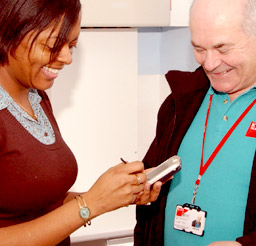


Who Are Kier Building Maintenance?
Kier Building Maintenance (KBM) operates within the Support Services division
of Kier Group, a £2.1 billion leading UK building and civil engineering contractor which also specialises in private house building, property development and the Private Finance Initiative.
Providing building maintenance services for a range of clients, including local and housing authorities, KBM last year carried out over half a million responsive repairs in more than 200,000 homes across the UK. For Sheffield City Council alone, KBM looks after more than 50,000 local authority homes, completing 165,000 responsive and out of hours jobs every year.
The desire for improved performance
Prior to the implementation of a mobile data system in 2006, KBM were looking for a more efficient way of receiving, scheduling and allocating jobs to field operatives. The company's key aims were to improve its internal, back office processes and raise the quality of service for tenants to an even higher level.
“We were already in the 90th percentile range in terms of our performance to our external tenants. We wanted to improve that even more, but in particular, we needed to address our internal processes for a more efficient means of job scheduling,” said Phil Oades, Service Manager for Responsive Repairs and Gas. “We were using a manual, paper-based system for job scheduling, which was not only time and paper intensive, but also subject to human error.”
The motivation for change
Ian Gregory, Call Centre Co-ordinator for Kier Sheffield, described supervisors systematically “trawling” for jobs. “Every twenty minutes or so, one of eight supervisors had to select a date range, print off a jobs list, and hand each job to the relevant person. Paper copies of each job were then placed on tables and sorted according to date and category – urgent or appointment. Urgent jobs were sub-divided into same day and 24 hour categories. Appointments were sorted according to date order and placed on the relevant member of office staff's desk in one of two tiers of trays covering the current and following weeks.”
With no facility for batch allocation in the system that they were using at the time, every office operative had to input the details of each individual job manually to ensure that there was always a clear audit trail. Then, the day before the appointments were due, office staff had to reorganise the jobs according to trade before placing them, along with any outstanding jobs from the previous day, into the appropriate field operative's envelope.
“Once jobs had been allocated in this way, supervisors would phone each field operative the night before or early the following day to relay every job detail off each job ticket,” continued Ian Gregory. “In most cases, we were giving seven or eight jobs to each operative at a time and all these details had to be transferred by the operative to a 'Bonus Sheet' at the other end. Obviously, this left a lot of room for human error and the wrong numbers or job codes were often written down, or handwriting was illegible. Because of this, and the fact that field operatives had to physically hand in their bonus sheets to another office for further processing, payment and response times, particularly for more complex jobs, were sometimes delayed.”
The supervisors, responsible for overseeing the work of over fifteen office staff and eighty field operatives, recognised the necessity for a more efficient and accurate system which would allow them to spend less time on administrative tasks and respond more effectively to customers' needs. At the very least, they wanted an application which was capable of batch allocation.
The first stepping stones
Working with Phil Oades, Service Manager for Responsive Repairs and Gas, Ian discovered that Sheffields' Operations Director, Simon Bullen, already had plans to invest in new technology and bring Kier Building Maintenance bang up to date. The move towards mobile data was already in the pipeline, and a system like Callsys®, which has synchronised and streamlined both business processes and IT systems for KBM, was vital if this move was to be realised.
It didn't take long for Callsys®, even in its infancy, to make a real difference to Kier Sheffield. “We thought it was fantastic,” said Ian Gregory. “It could do batch allocation, there was no trawling for jobs as they automatically came through on the dispatcher screen, and we could pull reports off the system with ease. When you allocated jobs in Callsys®, it automatically allocated them in Servitor. Rather than phoning work through to our field operatives to enable home starts, we were able to pull off a report and fax it to them. Although initially there was still a lot to input manually, it made such an immediate difference to the way we worked that those staff not taking part in the first trial were asking, 'When are we going to get it?'. It really was fantastic, as was the support we were given throughout the development, training and roll-out.”
Complete transformation
Callsys® has evolved incredibly since the first screens were released in 2005, and with its capacity to manage the entire workflow from call-taking through scheduling to electronic job approval, it has revolutionised the way Ian Gregory and his team at Kier Sheffield work. “We have job ownership from start to finish. We are more efficient, more productive and more cost conscious. We no longer have to phone operatives with jobs and response times are faster. Every stage of every job is captured accurately and in real time so we are able to sort out any problems that may arise straightaway. The need for bonus sheets has been eliminated and since the introduction of SMS appointment reminders, our field operatives make fewer abortive calls.”
Ian also highlights how easy it is to use Callsys®. “There has been absolutely no resistance to the Callsys® screens at any stage. At a glance, we can see – see the work, who's available, which jobs have been completed. It is easy to sort and re-direct labour. We're able to use our knowledge of job types, and field operatives' skills, preferences and locations to best allocate the work. We're in control.”
Chris Hone, Kier Support Services' IT Project Manager, is similarly impressed by the unprecedented control and operative visibility provided by Callsys®. “The key to success has been the simplicity of the user interface which allows a clear view of what needs to be done, by when and who is working on what at this time. Callsys® has allowed us to integrate different job management systems across our businesses into a single scheduling tool with a common mobile platform.”
In combination with KBM's chosen mobile solution, Callsys® manages the entire repair process, from initial notification of a job to signature capture and final sign-off from the tenant, in real time and via a paperless electronic system. Field operatives no longer have to travel to the depot to collect or return paperwork, resulting in less needless travel, more jobs per operative per day and reduced fuel use. The introduction of the Callsys-mobile data combination has also resulted in a significant saving on paper, drastically reducing Kier's carbon footprint.
Confidence in the future
As a result of a successful trial in Sheffield, Callsys® was rolled out in Islington and then across all Building Maintenance contracts at several other sites, including Harlow, Hull, Barking, Leeds and Stoke. Callsys® is now a key part of KBM's standard IT solution set and the scheduling system of choice on all new contracts. Across KBM, an estimated £4 million worth of work is now processed through Callsys® every month.
Following the success of the Callsys–Servitor integration, in 2007 Kier commissioned Cohesis to integrate Callsys® with COINS FM to enable the use of Callsys® and mobile working in Kier Facilities Services.
For one key user, Callsys® is an undeniable success. “I wouldn't change a thing,” said Ian Gregory. “It suits our needs perfectly at the moment, and I have every confidence that Cohesis could develop what we need, if and when we need it.”


















